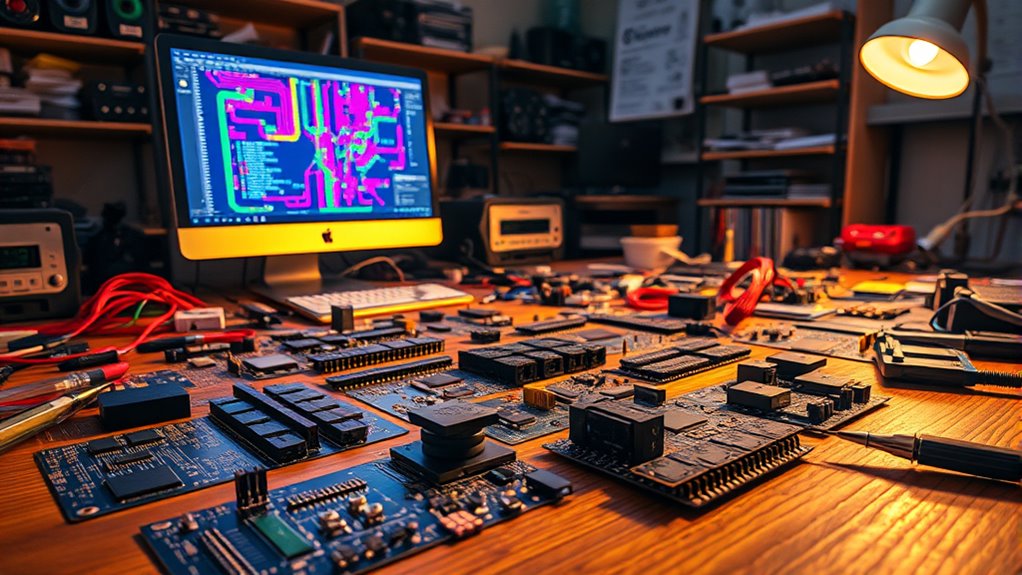Yes, community-built open-source chips can compete with industry giants by leveraging collaborative innovation, shared knowledge, and transparent designs. Open-source hardware allows diverse contributors to improve and customize chips rapidly, fostering versatile and cost-effective solutions. Although challenges like quality control and legal issues exist, dedicated communities continue to push boundaries and refine designs. If you’re curious about how these grassroots efforts are transforming technology, there’s more to discover about the potential of open-source hardware.
Key Takeaways
- Community-built chips foster innovation through collaborative design, enabling rapid development and customization beyond proprietary offerings.
- Open-source hardware promotes transparency, building trust and reliability comparable to industry giants’ products.
- Collective efforts reduce costs and resource barriers, allowing smaller groups to develop competitive, high-quality chips.
- Licensing clarity and design accuracy are crucial to ensure legal compliance and functional performance of community-designed chips.
- While challenging, open-source chips can compete with giants by leveraging community expertise, adaptability, and shared knowledge.

Open-source hardware refers to physical devices and components whose design files are made publicly available, allowing anyone to study, modify, and build upon them. This openness fosters a vibrant community where innovation thrives through shared knowledge. When you participate in open-source hardware projects, you engage in design collaboration, where diverse contributors bring their expertise to refine and improve designs. This collective effort accelerates development, often leading to more versatile and adaptable hardware than proprietary alternatives. However, navigating licensing challenges can complicate this collaborative environment. Different open-source licenses have varying rules about how designs can be used, modified, and redistributed. If you’re not careful, these legal nuances might restrict your ability to freely adapt hardware or could lead to inadvertent violations. Understanding licensing is crucial to ensure that your contributions remain compliant and that the community’s legal framework remains intact. Additionally, the quality and accuracy of open-source designs are vital for ensuring reliable and effective hardware development.
Frequently Asked Questions
How Does Open-Source Hardware Ensure Security and Privacy?
You guarantee security and privacy in open-source hardware by leveraging chip customization and community collaboration. When you customize chips, you can address specific security needs and integrate privacy features directly into the design. Community collaboration allows developers worldwide to review, test, and improve security measures, quickly identifying vulnerabilities. This collective effort makes open-source hardware more transparent, trustworthy, and resilient against threats, giving you a safer and more private device.
What Licensing Models Govern Open-Source Hardware Projects?
You should understand that licensing frameworks govern open-source hardware projects, defining how designs can be used, modified, and shared. These licenses protect intellectual property while encouraging collaboration. Common models include permissive licenses like MIT or BSD, which allow broad use, and copyleft licenses like GPL, which guarantee modifications remain open. By adhering to these licensing frameworks, you can contribute to community efforts while respecting creators’ rights.
How Do Community-Built Chips Compare in Performance to Commercial Ones?
Imagine you’re evaluating a community-built chip that’s custom-designed for specific tasks, like the RISC-V processors. These chips often meet or even surpass commercial ones in specific performance benchmarks, thanks to targeted optimizations. While they may not match the raw power of industry giants for all applications, their flexibility and cost-effectiveness make them competitive, especially in niche markets where customization and innovation drive performance.
What Funding Options Are Available for Open-Source Hardware Development?
You can explore various funding options for open-source hardware development, such as crowdfunding platforms like Kickstarter or Indiegogo, which let you gather support directly from the community. Additionally, government grants are available to fund innovative projects, providing essential resources without requiring equity. Combining these options helps you secure necessary funding, foster community engagement, and accelerate the development of your open-source hardware, making it more competitive and sustainable.
How Scalable Are Open-Source Hardware Solutions for Industrial Use?
You can find open-source hardware solutions quite scalable for industrial use, especially with proper manufacturing scalability strategies. By designing modular and adaptable components, you enable easier industrial integration and mass production. While challenges exist, such as meeting strict industry standards, open-source hardware can evolve to match industrial demands. Your focus on robust design and reliable supply chains will help guarantee these solutions effectively scale for large-scale manufacturing.
Conclusion
Just like a small river carving its own path through a vast landscape, open-source hardware shows you don’t need to be a giant to make waves. With passion, community, and innovation, your collective efforts can carve out niches that challenge industry giants. Every chip built, every idea shared, adds a ripple of change. So, keep pushing forward—your movement is the current shaping a future where community-built chips flow just as powerfully as those from the giants.









